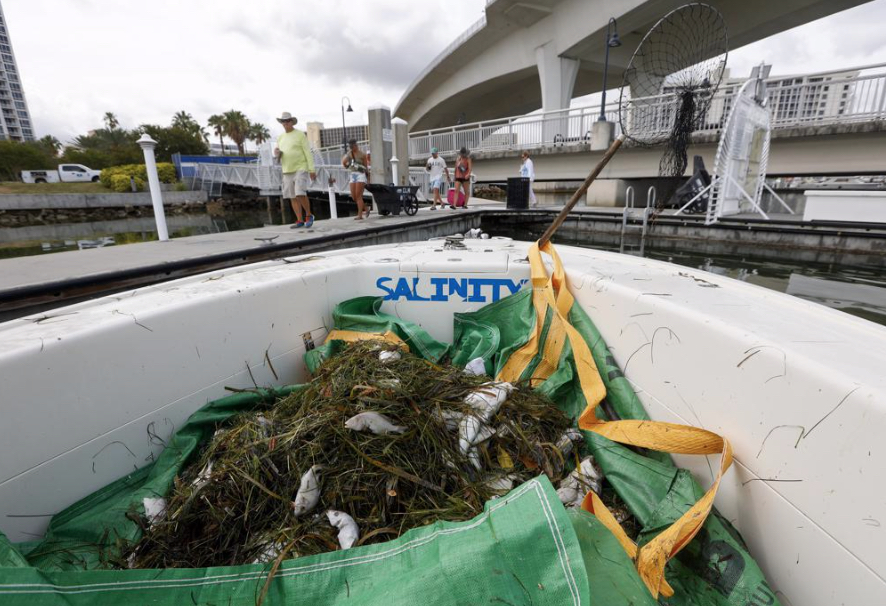
Plumes of toxic oceanic bacteria known as red tide continued to move up the western Florida coast, strewing thousands of dead fish on beaches while state officials tried to reassure Floridians and potential tourists Thursday that the outbreak was being taken seriously but isn’t as bad as it would seem.
Gov. Ron DeSantis on Thursday assembled a team of experts in St. Petersburg to describe the work that is underway to better understand and control the latest outbreak.
As the state’s economy continues to emerge from the devastation of the coronavirus pandemic, images of beaches littered with dead fish could threaten to keep visitors from flocking to seaside communities during the July 4 holiday.
Three years ago, massive blooms of the red tide prompted some beaches to close. The outbreak killed tons of aquatic life, littering coastlines with rotting fish and keeping people off the sand and water.
Widespread images of rotting fish and empty beaches could be catastrophic to the state’s tourism industry, which uses the state’s ample sunshine, sand and water to lure visitors to the state.
Officials are encouraging people to monitor beach conditions through an online dashboard.
Much of the current outbreak of the red tide bacteria, Karenia brevis, is centered in the Tampa Bay area. Even low concentrations have the potential for killing fish. Higher concentrations could affect some people if they swim in the water or eat contaminated shellfish, including oysters.
Fears over red tide prompted Florida officials late last month to briefly prohibit aquaculture farmers from harvesting in lower Tampa Bay, although the ban was lifted about 10 days later.
Experts assembled by the governor Thursday cautioned against linking the red tide outbreak to millions of gallons of polluted wastewater from an old fertilizer plant in Piney Point.
The experts said it’s doubtful the wastewater, which contains elevated levels of nitrogen, caused the red tide but acknowledged that it could be compounding the problem by providing nutrients for the bloom.
“I don’t think that the red tide was originated as a consequence of Piney Point,” said Tom Frazer, the state’s former science officer and dean of the University of South Florida’s College of Marine Science.
Fertilizers and other nutrients flowing into the coast from lawns, farms and septic tanks can also encourage blooms to spread.
____
Republished with permission from The Associated Press.




One comment
PeterH
June 21, 2021 at 1:11 pm
Florida is experiencing under-regulated agricultural run off and non- regulated 2.8 million septic tanks in Florida of which at least 280,000, are leaking. Most of this toxic mix leeches into the warm waters of the Gulf of Mexico. Run off is exacerbated by heavy summer rains.
Florida’s Soil and Water Conservation Commissioner has been reporting on this Gulf annual effluent environmental disaster for decades.
A few years ago, in the month of May, I visited relatives who live near Sanibel Island. The westerly brisk wind was causing Gulf turbulence which deposited a thick yellow foam along the beautiful beaches. After walking out on a pier and inhaling the musty air I encountered an allergic type reaction which affected breathing and eye membrane. I learned from a lifeguard station that my symptoms were typical and transient and suggested I stay in an air conditioned room for a few hours and stay several blocks away from the Gulf for the remainder of my stay..
If Marco Rubio, Rick Scott and Ron DeSantis want to do something advantageous for the people living in the State of Florida they should be meeting with President Biden’s infrastructure team, agricultural growers and Soil and Land management to find recommendations and remedies for this annual environmental quagmire. Earmark infrastructure money now …. so over the coming years the noted problems can be fixed.
Comments are closed.